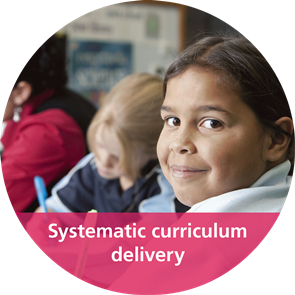
Systematic curriculum delivery
Description
A systematic approach to the curriculum is shared across the school and the wider school community through professional dialogue, collaborative planning and the systematic exchange of resources, programs and ideas.
Teachers clearly understand what they should teach and when, and show a level of commitment and activity that is reflected in a culture of shared responsibility.

NSW School Examples
 |
A Powerpoint presentation from MacKillop Catholic College, Warnervale, describes how reflection on data allowed the school to set goals, targets and strategies across the whole school to enhance student outcomes. Effective instructional leadership, professional development and the formation of teams has changed practice, with an emphasis on the systematic delivery of the most effective practices. |
 |
This PowerPoint from Warilla Public School in the Illawarra region of NSW, shows how strong instructional leadership from the Principal embedded a culture of high expectations, common methodologies for assessment and monitoring of progress across the curriculum based on evidence, and a rich environment to develop professional learning. |
 |
The Head of the Junior School at from Mountain View Adventist College discusses the changes brought about through the National Partnership which has supported planning across Stages, and has increased collaboration between teaching staff. |
 |
In this video the Head of the Junior School at Mountain View Adventist College discusses her role as instructional leader in bringing about Stage-based teaching plans. |
-
Systematic curriculum delivery - in detail
Collegiality and shared expectations
Consistency in delivering a coherent curriculum depends on the school sharing expectations, plans and processes for teaching, assessing and reporting on student progress. A collaborative whole school culture ensures that there will be a common approach to these tasks.
Contemporary research e.g. Zbar et al (2010), suggests that in a school characterised by a collaborative culture, there is an agreed deep belief that every student is capable of learning. Within these settings, it is clear that the sole purpose of the school is to enhance student learning and for these reasons a major priority is devoted to the development of positive and caring relationships among key stakeholders in the school, including parents. Masters (2010) describes how this can be done by ensuring that there is a "coherent sequenced plan for curriculum delivery that ensures teaching and learning expectations and a clear reference for monitoring learning across the year levels".
A coherent plan for curriculum delivery
Within collaborative environments in NSW schools (Erebus International (2012 and 2013), effective leaders build a climate of mutual trust and support where professional dialogue focuses on assisting students to maximise learning opportunities in the most systematic ways.
The most effective schools clearly negotiate and articulate the expectations of all staff, who are aware of each other’s responsibilities in relation to a shared plan for curriculum delivery. These schools demonstrate high levels of collegiality and the opportunity for professional sharing and mutual learning which facilitates the development of cross-curricular skills for both teachers and students.
The curriculum is the keystone which focuses effective practice
Masters (2010) notes that an evidence-based plan for curriculum delivery is the key to consistent teaching and learning expectations, and results in- sequenced plans across school years which set out what teachers should teach and students should learn
- a plan that is shared with and supported by the school community, including parents
- teachers being better equipped to construct learning experiences that are relevant, engaging and challenging for all students
- an alignment of curriculum, assessment and reporting processes and practices.
Supporting a shared vision of the curriculumProfessional learning teams are encouraged, working to enhance professional growth around topics/themes emerging as priorities and opportunities arising from a shared view of the whole-school curriculum. Teachers may have some time off class to share experiences, achievements and challenges. In some schools this also extends to the regular sharing of classroom teaching programs and related documentation for student learning.
Effective schools encourage professional accountability where all members of the school community work towards agreed outcomes and share achievements and challenges relating to individual accountabilities. However, while the focus must always be on addressing individual need, this is most effective in the context of shared and systematic processes, aligning teaching and assessment with curriculum expectations across year and stage groupings and across the whole school.
ReferencesErebus International (2012). Evaluation of the take-up and sustainability of new literacy and numeracy practices in NSW schools – Final Report for Phase 1, undertaken on behalf of the NSW Minister for Education
Erebus International (2013). Evaluation of the take-up and sustainability of new literacy and numeracy practices in NSW schools – Final Report for Phase 2, undertaken on behalf of the NSW Minister for Education
Masters, G. (2010.) Teaching and Learning School Improvement Framework. Australian Council for Educational Research (ACER)
Zbar, V.,Kimber, R. and Marshall, G. (2010). Getting the Preconditions for School Improvement in Place: How to Make it Happen. Centre for Strategic Education Seminar Series Bulletin 193: Melbourne
Whole school factors
Student learning of literacy and numeracy is most effective within a culture of school collaborative planning, exchange of teaching and learning ideas and systematic monitoring of student achievement across stage levels.
Student learning is enhanced with a whole school plan for curriculum delivery which includes the use of common language across the school community, including parents.
Classroom/teacher factors
Collaborative planning by teachers reflects an agreed common commitment to curriculum priorities, assessment and reporting of student outcomes, including to parents.
Teachers regularly share programming ideas and teaching tools across curriculum areas.
Discussion of student learning outcomes and planning for student learning occurs across stage levels.
See also
View this research on linking school targets to classroom practice from evidence-based planning for teaching and learning observed at Rosemeadow Public school.
Read this edition of the Australian Education Review by Gabrielle Matters on Using Data to Support Learning in Schools, published in 2006 by ACER.
Explore resources around data-driven decision-making produced by e-Lead, a Washington-based organisation.

